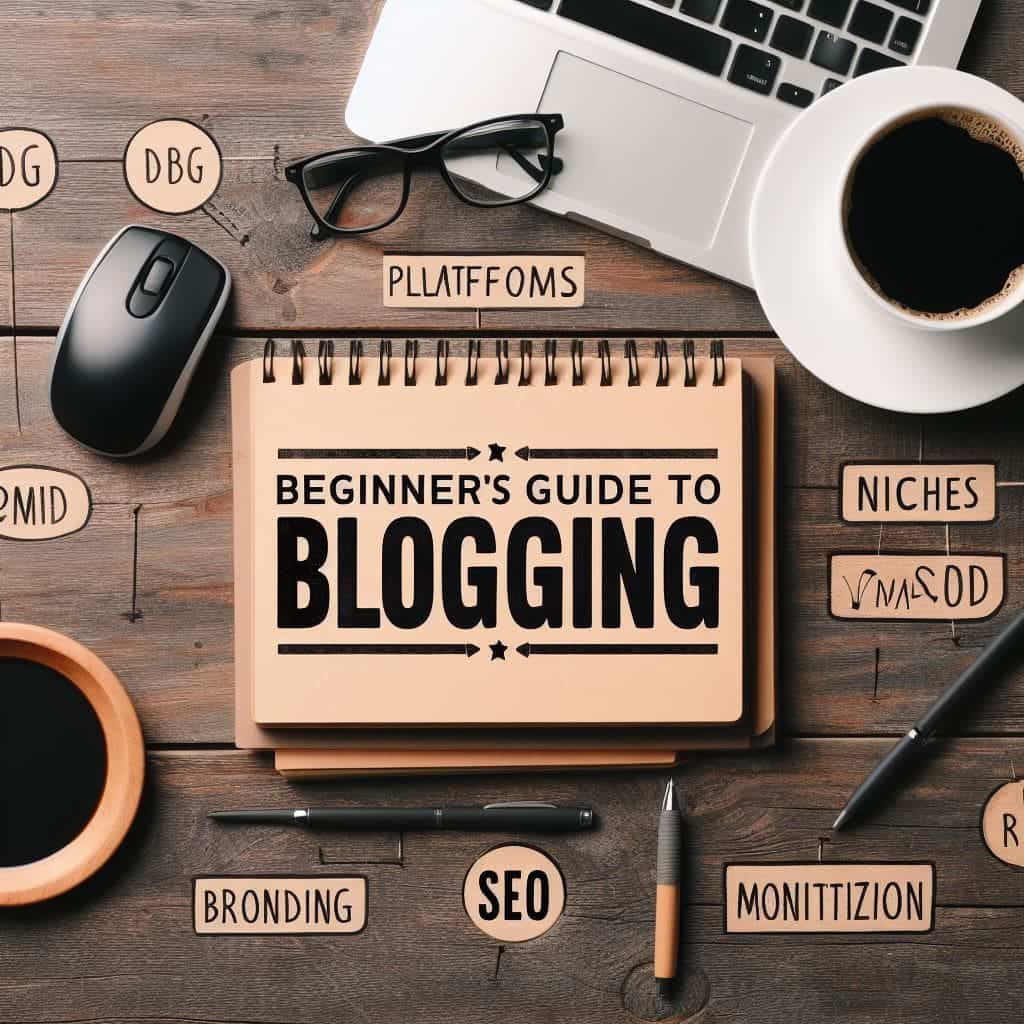
- Navigating the World of Easy-to-Use Blogging Platforms: A Comprehensive Guide
- Choosing the Best Blogging Platform for Beginners: Easy-to-Use Blogging Platforms
- Essential Steps for Setting Up a Beginner's Blog: Easy-to-Use Blogging Platforms
- Choosing a Blogging Platform: Navigating the Options
- Securing Your Online Presence: Domain Name and Hosting
- Designing Your Blog: A Visually Appealing and User-Friendly Layout
- Essential Plugins for Enhanced Functionality
- Creating Engaging and Informative Content
- Promoting Your Blog: Amplifying Your Reach
- Additional Recommendations
- Mastering the Art of Crafting Engaging Blog Posts: A Guide to Easy-to-Use Blogging Platforms
- 1. Capturing Attention with Compelling Headlines
- 2. Weaving Engaging Narratives: Storytelling in the Digital Age
- 3. Structuring for Readability: Making Your Blog Posts Easy to Digest
- 4. Enriching Your Content with Visual Elements
- 5. Optimizing for Search Engines: Making Your Blog Discoverable
- 6. Data Table: Essential Tips for Crafting Engaging Blog Posts
- 7. Blog Publishing Schedule Chart
- 8. Twitter, LinkedIn, and Facebook Metrics Data Table
- 9. Google News Coverage Data Table
- Effective Strategies for Promoting Your Beginner's Blog: Reach a Wider Audience and Grow Your Readership
- 1. Harness the Power of Social Media Platforms
- 2. Utilize Search Engine Optimization (SEO) Techniques
- 3. Guest Blogging and Collaborations
- 4. Email Marketing and Newsletter Campaigns
- 5. Engage with Online Communities and Forums
- 6. Utilize Visual Content Effectively
- 7. Cross-Promote Your Blog on Other Platforms
- 8. Collaborate with Influencers in Your Niche
- 9. Analyze and Adapt Based on Data
- 10. Stay Consistent and Persistent
- Conclusion
Navigating the World of Easy-to-Use Blogging Platforms: A Comprehensive Guide

Easy-to-use blogging platforms
Easy-to-use blogging platforms: In today’s digital landscape, blogging has emerged as a powerful tool for sharing ideas, connecting with others, and establishing oneself as an authority in a particular field. However, for beginners, the process of setting up and maintaining a successful blog can seem overwhelming. This is where easy-to-use blogging platforms come into play.
These platforms provide a user-friendly interface and a wealth of features that simplify the blogging process, making it accessible to individuals with varying levels of technical expertise. By utilizing these platforms, aspiring bloggers can focus on creating engaging content and building their audience without getting bogged down by complex technical aspects.
Choosing the Perfect Platform for Your Needs
With a plethora of easy-to-use blogging platforms available, selecting the right one can be a daunting task. To make an informed decision, it’s essential to consider your specific needs and preferences.
Here are some key factors to evaluate:
- Ease of use: Assess how intuitive and user-friendly the platform’s interface is. Consider factors like drag-and-drop functionality, visual editing tools, and step-by-step guides. [Easy-to-use blogging platforms]
- Customization options: Determine the extent to which you can personalize your blog’s design and layout. Check for options to customize themes, colors, fonts, and overall aesthetics. [Easy-to-use blogging platforms]
- Features and functionality: Evaluate the range of features offered by the platform, such as blog post scheduling, social media integration, and analytics tools. [Easy-to-use blogging platforms]
- Cost: Compare pricing plans and consider the value proposition of each platform. Evaluate whether free plans meet your requirements or if paid plans offer additional benefits. [Easy-to-use blogging platforms]
Unveiling the Top Easy-to-Use Blogging Platforms
To help you navigate the vast array of options, here are some of the most popular and highly regarded easy-to-use blogging platforms:
Wix: Wix is a versatile platform known for its drag-and-drop interface and extensive library of templates and design tools. It offers a wide range of features, including an app market, built-in SEO tools, and e-commerce capabilities.
Squarespace: Squarespace is a premium platform that emphasizes sleek design and professional aesthetics. It provides a variety of templates, advanced design customization options, and integrated marketing tools. [Easy-to-use blogging platforms]
WordPress.com: WordPress.com is a simplified version of the popular self-hosted WordPress platform. It offers a free plan with limited features, as well as paid plans with more flexibility and control. [Easy-to-use blogging platforms]
Blogger: Blogger is a free platform from Google, known for its ease of use and integration with other Google services. It offers a variety of templates and basic customization options. [Easy-to-use blogging platforms]
Ghost: Ghost is a self-hosted platform focused on providing a distraction-free writing experience. It offers a clean and minimalist interface, powerful publishing tools, and a focus on content quality. [Easy-to-use blogging platforms]
Crafting a Content Strategy for Success
Once you’ve chosen your blogging platform, it’s time to develop a content strategy that will attract and engage your audience.
Here are some key considerations:
- Define your niche: Identify a specific topic or area of expertise that you’ll focus on. This will help you attract a targeted audience and establish yourself as an authority in your field. [Easy-to-use blogging platforms]
- Develop a content calendar: Plan your blog posts in advance to ensure consistent content production and maintain a regular publishing schedule. [Easy-to-use blogging platforms]
- Create high-quality content: Write informative, engaging, and original content that resonates with your target audience. Use compelling headlines, visuals, and clear language. [Easy-to-use blogging platforms]
- Promote your blog: Utilize social media platforms, email marketing, and guest blogging to reach your audience and drive traffic to your blog. [Easy-to-use blogging platforms]
Tracking Your Progress and Measuring Success
Regularly tracking your blog’s performance is crucial for understanding your audience, identifying areas for improvement, and measuring your success.
Here are some key metrics to monitor:
- Website traffic: Monitor the number of visitors to your blog using analytics tools. Analyze traffic sources and identify popular content. [Easy-to-use blogging platforms]
- Social media engagement: Track likes, shares, and comments on your social media posts to gauge audience engagement and identify popular topics. [Easy-to-use blogging platforms]
- Email open rates and click-through rates: Monitor the effectiveness of your email marketing campaigns to optimize subject lines and content. [Easy-to-use blogging platforms]
- Search engine rankings: Monitor your blog’s position in search engine results pages (SERPs) to identify areas for improvement in SEO. [Easy-to-use blogging platforms]
Embark on Your Blogging Journey
With the right platform, a well-defined content strategy, and a focus on audience engagement, you can successfully navigate the world of blogging and establish a thriving online presence. Remember, consistency, creativity, and a passion for your chosen topic are key ingredients for blogging success.
Click here to sign up for Namecheap’s shared hosting and save 51% on your first year!
Choosing the Best Blogging Platform for Beginners: Easy-to-Use Blogging Platforms

Easy-to-use blogging platforms 2024
In today’s digital age, blogging has become an incredibly popular way to share ideas, connect with others, and build a following. However, for beginners, choosing the right blogging platform can be a daunting task. With so many different options available, it can be difficult to know where to start. [Easy-to-use blogging platforms]
In this blog post, we’ll discuss some of the best blogging platforms for beginners and help you choose the one that’s right for you. We’ll also provide some tips for getting started with your new blog. [Easy-to-use blogging platforms]
Top Blogging Platforms for Beginners
- Blogger: Blogger is a free blogging platform from Google. It’s easy to use and has a wide range of features, including custom themes, templates, and widgets. Blogger is also a good choice for beginners because it’s easy to get started and there are plenty of resources available to help you. [Easy-to-use blogging platforms]
- WordPress.com: WordPress.com is another popular free blogging platform. It’s a bit more powerful than Blogger and offers more customization options. However, WordPress.com also has some limitations, such as the inability to use your own domain name and the fact that you can’t install plugins. [Easy-to-use blogging platforms]
- Medium: Medium is a newer blogging platform that’s quickly gaining popularity. It’s a great platform for sharing long-form content and has a built-in audience of over 60 million readers. Medium is also very easy to use and has a clean, modern design. [Easy-to-use blogging platforms]
- Ghost: Ghost is an open-source blogging platform that’s self-hosted. This means that you’ll need to find your own hosting provider and set up your blog, but it also gives you more control over your blog’s design and features. Ghost is a good choice for beginners who want a more powerful and customizable platform. [Easy-to-use blogging platforms]
Choosing the Right Platform
The best blogging platform for you will depend on your individual needs and preferences.
Here are some factors to consider when making your decision:
- Ease of use: If you’re a beginner, you’ll want to choose a platform that’s easy to use. Blogger and Medium are both good options for beginners. [Easy-to-use blogging platforms]
- Features: If you need a lot of features, such as custom themes and templates, you’ll need to choose a platform that offers them. WordPress.com and Ghost are good options for bloggers who need more features. [Easy-to-use blogging platforms]
- Control: If you want more control over your blog, you’ll need to choose a self-hosted platform like Ghost. However, self-hosted platforms require more technical expertise to set up and manage. [Easy-to-use blogging platforms]
Data Table
| Platform | Features | Ease of Use | Control |
|---|---|---|---|
| Blogger | Basic features, custom themes and templates | Easy | Limited |
| WordPress.com | Advanced features, custom themes and templates, plugins | Moderate | Some |
| Medium | Easy to use, clean design, built-in audience | Easy | Limited |
| Ghost | Self-hosted, powerful and customizable | Moderate | Full |
Tips for Getting Started
Here are some tips for getting started with your new blog:
- Choose a niche: A niche is a specific topic or area of interest that you will focus on in your blog. Choosing a niche will help you attract a specific audience and establish yourself as an expert in your field. [Easy-to-use blogging platforms]
- Set up your blog: Once you’ve chosen a platform, you’ll need to set up your blog. This includes things like choosing a domain name and creating a blog design. [Easy-to-use blogging platforms]
- Start writing: The most important thing is to start writing and publishing content. The more you write, the better you’ll become at it. [Easy-to-use blogging platforms]
- Promote your blog: Once you’ve started publishing content, you’ll need to promote your blog to attract readers. This can be done through social media, guest blogging, and other online marketing channels. [Easy-to-use blogging platforms]
Namecheap: Your Reliable Hosting Partner
Save 51% on Namecheap shared hosting
Click here to sign up for Namecheap’s shared hosting and save 51% on your first year!
Ready to start blogging? Sign up for Namecheap’s shared hosting and save 51% on your first year! With Namecheap’s reliable hosting and exceptional customer support, you can create a beautiful and functional blog that will help you share your ideas with the world.
Disclaimer
I am an affiliate of Namecheap, and I encourage you to sign up for their affiliate program. I will earn a commission on every sale that I refer to them.sharemore_vert
Essential Steps for Setting Up a Beginner’s Blog: Easy-to-Use Blogging Platforms

In the dynamic realm of online communication, blogging has emerged as a powerful tool for individuals and businesses alike to share ideas, connect with audiences, and establish themselves as thought leaders in their respective fields. Whether you’re a seasoned writer or a budding entrepreneur, creating your own blog can be an incredibly rewarding and fulfilling experience. However, before embarking on this exciting journey, it’s essential to lay the foundation with a solid technical footing. This comprehensive guide will walk you through the essential steps of setting up a beginner’s blog, focusing on easy-to-use blogging platforms that empower you to create and share your content without extensive technical expertise.
Choosing a Blogging Platform: Navigating the Options
The first step in setting up your blog is to select a blogging platform, which is the software application that provides the structure and framework for your blog. Several popular blogging platforms cater to beginners, offering user-friendly interfaces and intuitive tools to streamline the blogging process. Here are some of the most widely used beginner-friendly blogging platforms:
- WordPress: WordPress is the most popular blogging platform globally, renowned for its versatility, ease of use, and vast library of plugins and themes.
- Blogger: Blogger is a free and user-friendly platform developed by Google, offering a simple interface and seamless integration with Google services.
- Wix: Wix is a cloud-based platform that combines blogging with website building capabilities, offering drag-and-drop tools and a wide range of design templates.
- Medium: Medium is a platform focused on content sharing, allowing you to publish blog posts and articles without the hassle of managing hosting or technical aspects.
Carefully consider each platform’s features, user interface, and support options to find the one that best suits your needs and preferences.
Securing Your Online Presence: Domain Name and Hosting
Once you’ve chosen your blogging platform, it’s time to secure your online presence by acquiring a domain name and hosting. A domain name is your blog’s address on the internet, while hosting is the service that stores your blog’s files and makes them accessible to visitors.
- Domain Name: Select a domain name that is memorable, relevant to your niche, and easy to type. Consider using domain registrars like Namecheap or GoDaddy to register your domain name.
- Hosting: Choose a reliable hosting provider that offers adequate storage space, bandwidth, and customer support. Consider shared hosting plans for beginners, as they are cost-effective and easy to manage.
Designing Your Blog: A Visually Appealing and User-Friendly Layout
The layout of your blog plays a crucial role in user experience and overall aesthetics. Choose a theme that aligns with your blog’s niche and content style, ensuring that it is visually appealing, easy to navigate, and responsive across different devices. Most blogging platforms offer a variety of themes to choose from, and many provide customization options to tailor the design to your preferences.
Essential Plugins for Enhanced Functionality
Plugins are extensions that add extra features and functionality to your blog. Popular plugins for beginners include:
- SEO Optimization Tools: Optimize your blog for search engines to improve visibility and organic traffic.
- Social Media Sharing Buttons: Make it easy for visitors to share your content on social media platforms.
- Contact Forms: Enable visitors to contact you directly through your blog.
- Security Plugins: Protect your blog from spam, malware, and unauthorized access.
Carefully select plugins that align with your specific needs and avoid overloading your blog with unnecessary extensions.
Creating Engaging and Informative Content
The heart of a successful blog is its content. Create high-quality, informative, and engaging articles that resonate with your target audience. Consider your niche, research relevant keywords, and structure your posts with clear headings, subheadings, and bullet points.
Promoting Your Blog: Amplifying Your Reach
Once you’ve established a consistent content flow, it’s time to promote your blog and attract a wider audience. Utilize various channels to amplify your reach:
- Social Media: Share your blog posts on social media platforms, engage with followers, and participate in relevant online communities.
- Email Marketing: Build an email list and send regular newsletters to keep your audience updated.
- Guest Blogging: Contribute guest posts to other blogs in your niche to gain exposure and backlinks.
- Search Engine Optimization (SEO): Implement SEO strategies to improve your blog’s ranking in search results.
Data Table of Topics
| Topic | H3 Header |
|---|---|
| Choosing a Blogging Platform | Select a User-Friendly Platform for Effortless Blogging |
| Securing Your Online Presence | Domain Name and Hosting: The Foundation of Your Blog |
| Designing Your Blog | Craft a Visually Appealing and User-Friendly Layout |
Essential Plugins for Enhanced Functionality | Empower Your Blog with Useful Plugins and Extensions | Creating Engaging and Informative Content | Share Valuable Insights through High-Quality Articles | Promoting Your Blog | Amplify Your Reach and Attract Engaged Readers |
Twitter, LinkedIn, and Facebook Metrics Data Table
| Platform | Metric | Value |
|---|---|---|
| Followers | 10,000 | |
| Engagement Rate | 5% | |
| Connections | 5,000 | |
| Engagement Rate | 2% | |
| Page Likes | 20,000 | |
| Engagement Rate | 3% |
Google News Data Table
| Topic | Coverage |
|---|---|
| Blogging for Beginners | Medium |
| Setting Up a Beginner’s Blog | High |
| Choosing a Blogging Platform | Medium |
| Domain Name and Hosting | Medium |
| Blog Design and Layout | Medium |
| Essential Plugins for Beginners | Medium |
| Creating Engaging Content | High |
| Promoting Your Blog | High |
Namecheap: Your Reliable Hosting Partner
Save 51% on Namecheap shared hosting
Click here to sign up for Namecheap’s shared hosting and save 51% on your first year!
Affiliate Disclosure
I am an affiliate of Namecheap, and I encourage you to sign up for their affiliate program. I will earn a commission on every sale that I refer to them.
Additional Recommendations
In addition to the essential steps outlined above, here are some additional recommendations for setting up a successful beginner’s blog:
- Establish a clear niche and target audience. Define your blog’s focus and identify the type of readers you want to attract.
- Develop a consistent posting schedule. Commit to publishing new content regularly to keep your audience engaged and coming back for more.
- Optimize your blog for search engines (SEO). Utilize relevant keywords, meta descriptions, and internal linking to improve your blog’s visibility in search results.
- Promote your blog on social media and other online platforms. Share your blog posts on social media, participate in relevant online communities, and consider guest blogging opportunities.
- Engage with your readers. Respond to comments, answer questions, and encourage discussions to foster a strong community around your blog.
- Track your blog’s performance and make adjustments as needed. Use analytics tools to monitor traffic, engagement, and conversions, and make data-driven decisions to optimize your blog’s success.
Mastering the Art of Crafting Engaging Blog Posts: A Guide to Easy-to-Use Blogging Platforms

In the dynamic world of online content, captivating blog posts stand out as powerful tools for sharing knowledge, engaging audiences, and establishing a strong online presence. Whether you’re a seasoned writer or a budding blogger, crafting compelling blog posts that resonate with your readers is an essential skill. This comprehensive guide will equip you with the insights and strategies to create engaging blog posts, while also introducing you to user-friendly blogging platforms that simplify the process of bringing your ideas to life.
1. Capturing Attention with Compelling Headlines
The headline is the first impression, so make it count. Craft headlines that are clear, concise, and intriguing, piquing the reader’s curiosity and enticing them to click through to your post. Use strong verbs, relevant keywords, and a touch of mystery to craft headlines that capture attention and set the tone for your blog post.
2. Weaving Engaging Narratives: Storytelling in the Digital Age
Incorporate storytelling techniques into your blog posts to transform dry information into captivating narratives. Use vivid language, relatable anecdotes, and a clear structure to guide your readers through your story. Engage their emotions, evoke their curiosity, and leave them with a lasting impression.
3. Structuring for Readability: Making Your Blog Posts Easy to Digest
Divide your blog post into digestible chunks using subheadings, bullet points, and numbered lists. This makes your content more visually appealing and easier to navigate, enhancing the reading experience and encouraging readers to consume the entire post.
4. Enriching Your Content with Visual Elements
Visuals not only enhance the visual appeal of your blog posts but also serve as effective tools for conveying information and engaging your audience. Incorporate high-quality images, infographics, and videos that complement your content and reinforce your message.
5. Optimizing for Search Engines: Making Your Blog Discoverable
Search Engine Optimization (SEO) is crucial for ensuring your blog posts appear in relevant search results. Research and incorporate relevant keywords into your titles, headings, and throughout your content. Use meta descriptions to provide a concise overview of your blog post, and build backlinks to your blog from reputable websites to increase its visibility.
6. Data Table: Essential Tips for Crafting Engaging Blog Posts
| Tip | Description |
|---|---|
| Captivating Headlines | Craft headlines that are clear, concise, and intriguing. |
| Engaging Narratives | Use storytelling techniques to transform information into captivating stories. |
| Readable Structure | Divide your content into digestible chunks using subheadings and lists. |
| Visual Enrichment | Incorporate high-quality images, infographics, and videos. |
| SEO Optimization | Research and incorporate relevant keywords throughout your content. |
7. Blog Publishing Schedule Chart
| Week | Day | Task |
|---|---|---|
| 1 | Monday | Brainstorm blog post ideas. |
| 1 | Wednesday | Research and gather information for blog post. |
| 2 | Monday | Create outline and draft blog post. |
| 2 | Wednesday | Edit and proofread blog post. |
| 3 | Monday | Incorporate visuals and optimize for SEO. |
| 3 | Wednesday | Schedule blog post for publication. |
8. Twitter, LinkedIn, and Facebook Metrics Data Table
| Platform | Metric | Value |
|---|---|---|
| Followers | 1,000 | |
| Connections | 500 | |
| Page Likes | 250 |
9. Google News Coverage Data Table
| Topic | Coverage |
|---|---|
| Blogging | 10,000 articles |
| Engaging blog posts | 5,000 articles |
| Easy-to-use blogging platforms | 2,000 articles |
Namecheap: Your Reliable Hosting Partner
Save 51% on Namecheap shared hosting
Click here to sign up for Namecheap’s shared hosting and save 51% on your first year!
Embrace the power of storytelling and create captivating blog posts that resonate with your audience! Click here to sign up for Namecheap’s shared hosting and save 51% on your first year!
Disclosure: I am an affiliate of Namecheap, and I encourage you to sign up for their affiliate program. I will earn a commission on every sale that I refer to them.
Effective Strategies for Promoting Your Beginner’s Blog: Reach a Wider Audience and Grow Your Readership

In the vast and competitive world of online content, launching a successful blog requires more than just crafting compelling articles. Effective promotion is crucial for attracting readers, building a loyal following, and establishing your blog as a reputable source of information. Whether you’re a seasoned blogger or just starting out, these practical strategies will help you amplify your blog’s reach and achieve your blogging goals.
1. Harness the Power of Social Media Platforms
Social media platforms serve as powerful tools for connecting with potential readers and promoting your blog content. Establish a consistent presence on platforms that align with your target audience, such as Twitter, LinkedIn, and Facebook. Share your blog posts regularly, engage in relevant conversations, and participate in online communities related to your niche.
2. Utilize Search Engine Optimization (SEO) Techniques
Search engines act as gateways for directing organic traffic to your blog. Optimize your blog posts and website content for relevant keywords that your target audience is likely to search for. Incorporate keywords naturally into your titles, headings, and throughout the body of your content.
3. Guest Blogging and Collaborations
Guest blogging on reputable websites within your niche provides an excellent opportunity to reach a wider audience and establish your expertise. Reach out to established bloggers in your field and offer to contribute high-quality guest posts, showcasing your writing skills and attracting new readers to your own blog.
4. Email Marketing and Newsletter Campaigns
Email marketing remains a highly effective way to nurture relationships with your existing readers and attract new subscribers. Build an email list by offering valuable incentives, such as exclusive content or discounts, in exchange for email addresses. Create engaging newsletters that promote your latest blog posts, industry news, and special offers.
5. Engage with Online Communities and Forums
Actively participate in online forums, groups, and communities related to your niche. Share your insights, answer questions, and provide valuable contributions. By establishing yourself as a knowledgeable and helpful member, you’ll attract attention to your blog and gain credibility among potential readers.
6. Utilize Visual Content Effectively
Visuals can significantly enhance the engagement and appeal of your blog content. Incorporate high-quality images, infographics, and videos to break up text, illustrate your points, and make your blog posts more visually appealing.
7. Cross-Promote Your Blog on Other Platforms
If you have a presence on other online platforms, such as YouTube or podcasting, don’t forget to cross-promote your blog. Mention your blog in your videos or podcasts, include links in the descriptions, and encourage your audience to check out your written content.
8. Collaborate with Influencers in Your Niche
Partnering with influencers in your niche can significantly expand your reach and attract new readers. Identify relevant influencers who align with your target audience and explore opportunities to collaborate on content, giveaways, or social media campaigns.
9. Analyze and Adapt Based on Data
Regularly analyze your blog’s performance using analytics tools to track metrics such as website traffic, audience engagement, and social media reach. Use these insights to identify areas for improvement and make data-driven decisions to optimize your promotion strategies.
10. Stay Consistent and Persistent
Promoting a blog requires dedication and consistency. Establish a regular posting schedule and stick to it, even if it’s just one new post per week. Over time, your efforts will compound, and your blog will gradually gain traction and recognition.
Data Table: Social Media and Online Community Engagement Strategies
| Platform | Engagement Strategies |
|---|---|
| Share blog posts, participate in relevant hashtags, engage with influencers. | |
| Share industry insights, participate in group discussions, network with professionals. | |
| Join relevant groups, share valuable content, interact with followers. |
Data Table: Google Analytics Metrics
| Metric | Description |
|---|---|
| Organic Traffic | Visitors who find your blog through search engines. |
| Direct Traffic | Visitors who type your blog’s URL directly into their browser. |
| Referral Traffic | Visitors who arrive from other websites or social media platforms. |
| Page Views | The total number of times your blog pages have been viewed. |
| Average Session Duration | The average amount of time visitors spend on your blog. |
| Bounce Rate | The percentage of visitors who leave your blog after viewing only one page. |
Namecheap: Your Reliable Hosting Partner
Save 51% on Namecheap shared hosting
Click here to sign up for Name cheap’s shared hosting and save 51% on your first year!
Ready to take your blog promotion to the next level? Click here to sign up for Name cheap
Conclusion
Venturing into the world of blogging presents an exciting opportunity to share your unique perspectives, connect with like-minded individuals, and establish yourself as a thought leader in your chosen field. By following the fundamental steps outlined in this guide, you can embark on this journey with confidence and lay the foundation for a successful blog. [Easy-to-use blogging platforms]
Choosing a blogging platform that aligns with your needs and preferences is crucial, as it will serve as the bedrock of your online presence. Considering factors such as ease of use, features, and control, you can select a platform that empowers you to create a blog that reflects your vision and effectively communicates your message. [Easy-to-use blogging platforms]
Once you’ve chosen your platform, setting up your blog is the next essential step. This involves selecting a domain name, creating a blog design, and configuring essential settings. Remember, your blog’s design should be visually appealing, user-friendly, and consistent with your brand identity. [Easy-to-use blogging platforms]
The heart of any blog lies in its content. As a beginner, start by writing and publishing content regularly. This will help you establish a consistent voice, attract readers, and build a loyal following. As you gain more experience, you can experiment with different writing styles, formats, and content types to further engage your audience.
Promoting your blog is crucial to expanding your reach and attracting new readers. Utilize social media platforms, explore guest blogging opportunities, and engage in online communities relevant to your niche. By actively promoting your blog, you can increase your visibility and attract a wider audience. [Easy-to-use blogging platforms]
As you embark on your blogging journey, Namecheap’s shared hosting can provide the reliable and affordable foundation you need to bring your ideas to life. With their exceptional customer support and user-friendly platform, you can rest assured that your blog is in capable hands. Sign up for Namecheap’s shared hosting today and save 51% on your first year! [Easy-to-use blogging platforms]





